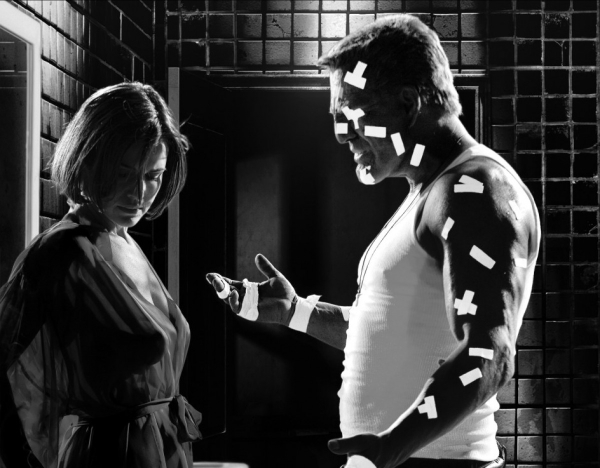Movie review by Greg Carlson
A tour de force of hard-boiled crime fiction clichés and pulpy noir fever dreams, “Sin City” is the first exciting movie to be released in 2005. Tenaciously faithful to comic book deity Frank Miller’s popular series, “Sin City” boasts a volcanic ferocity that will quicken the pulse and tighten the pants of scores of drooling, perspiring, adolescent and post-adolescent fanboys. Helmed by Miller and Robert Rodriguez (with a well-tuned scene by special guest director Quentin Tarantino), “Sin City” succeeds almost solely on the slavishness of its adherence to Miller’s gloriously penciled and inked panels. Seldom has a movie recreated the particular experience of reading comic books.
Reconstructing four of Miller’s stories (only three of which get the full treatment), “Sin City” likes to find a single exposed nerve and poke it over and over. The major protagonists all seem to define themselves as protectors of women – despite the fact that some of the females in Sin City clearly don’t need protecting. Add to that creaky chivalric trope Miller’s never-ending castration and emasculation motif and you have a recipe that seems certain to part America’s teenagers from their allowances (assuming they can sneak past the decidedly R rating).
As usual, violence trumps sex as the socially acceptable graphic engine that drives our voyeuristic lust, and despite the parade of barely-clad hotties in impossibly skimpy bondage-wear, Miller and Rodriguez are much more comfortable when they can focus on the two-fisted sadism that chokes nearly every CGI frame of their visual experiment. The filmmakers revel in the various ways street justice is meted out: arrows thump through chests, necks are chomped, limbs are separated from bodies, heads are stomped into unrecognizable puddles of bone and brain, and so on. Male genitals suffer every indignity: kicked, stabbed, and shot off, nuts are the target du jour.
Despite the casting of a parade of A-list talent, it is the seemingly washed-up Mickey Rourke who delivers the movie’s only really great performance. As the relentless, unstable Marv, Rourke manages something none of his co-stars can muster: he brings his character to vivid, muscular life. Buried under a mask of prosthetics, Rourke infuses Marv with both the brutal despair of a condemned prisoner and the rabid dangerousness of a wounded predator. Cracking spines and crushing skulls like a supernatural killing machine, Rourke seems to have found the role of a lifetime.
While the other major stories deliver their fair share of gut-bucket mayhem, Rodriguez and Miller seem too preoccupied with the stylish production design to bother much with script mechanics. “Sin City,” heavily influenced by “Pulp Fiction,” fails to intertwine its narrative threads as deftly as Tarantino did in his landmark film. One could argue that “Sin City” is meant to play like the comic book all the way down to its episodic structure, but great cinema has its own set of demands. At more than two hours, the movie version nearly wears out its welcome, and it is in large measure due to the lumbering, one-thing-at-a-time approach to the material. Even so, the movie’s eye-popping visuals nearly make up for its deficiencies, and “Sin City” already looks like a cult destination.
